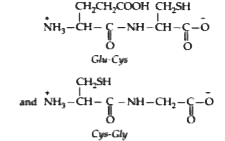A tripeptide (X) on partial hydrolysis gave two dipeptides Cys-Gly and Glu-Cys, i.e.,

Identify the tripeptide.
Glu -Cys- Gly
Gly-Glu-Cys
Cys-Gly-Glu
Cys-Glu - Gly
The correct Answer is:A
Since the tripeptide on hydrolysis gave two dipeptides Glu-Cys and Cys-Gly. Hence, cystine must be in between glutamic acid and glycine as given below.

Topper's Solved these Questions
- BIOMOLECULESBOOK - MTG GUIDECHAPTER - BIOMOLECULESEXERCISE - HORMONES AND VITAMINS
25 Videos
- BIOMOLECULESBOOK - MTG GUIDECHAPTER - BIOMOLECULESEXERCISE - CHECK YOUR NEET VITALS
25 Videos
- BIOMOLECULESBOOK - MTG GUIDECHAPTER - BIOMOLECULESEXERCISE - CARBOHYDRATES
64 Videos
- ALDEHYDES, KETONES AND CARBOXYLIC ACIDS BOOK - MTG GUIDECHAPTER - ALDEHYDES, KETONES AND CARBOXYLIC ACIDS EXERCISE - AIPMT/NEET
31 Videos
- CHEMICAL KINETICSBOOK - MTG GUIDECHAPTER - CHEMICAL KINETICSEXERCISE - AIPMT/NEET (MCQs)
22 Videos
Similar Questions
A tripeptide (X) on hydrolysis gives three amino acids (A)⎛⎜ ⎜⎝NH2−C∣RH−COOH⎞⎟ ⎟⎠,
(B)⎛⎜ ⎜⎝NH2−C∣R'H−COOH⎞⎟ ⎟⎠, and
(C)⎛⎜ ⎜⎝NH2−C∣R'H−COOH⎞⎟ ⎟⎠.(X) and reaction with NH2NH2 gives a dipeptide (Y) and amino acid (B).
The dipeptide (Y) is hydrolysed by carboxypeptidase enzyme and gives amino acid (A). what is the structure of (X)?
View SolutionAtetrapeptide on complete hydrolysis gave Alanine, Glycine, Leucine and valine . It never gave Ala-Gly and Val-Ala on partial hydrolysis. How many such tetrapeptides are possible ?
View Solution
Knowledge Check
A tripeptide (X) on partial hydrolysis gave the dipeptides Gly-Cys and Cys-Gly, i.e.
⊕NH3−CH2CH2COOH∣CH−C∣∣OGlu-Cys−NH−CH2SH∣CH−C∣∣O−ΘO
⊕NH3−CH2SH∣CH−C∣∣OCys-Gly−NH−CH2−C∣∣O−ΘO
Identify the tripeptide.AGly-Glu-CysBGly-Glu-CysCCys-Gly-GluDCys-Glu-GlyA hexapeptide has the composition Ala,Gly,Phe,Val. Both the N− terminal and C− teminal units are Val. Cleavage of the hexapeptide by chymotypsin gives two different tripeptides, both having Val as the N-terminal group. Among the products of random hydrolysis is a Ala−Val dipeptide fragment . What is the primary structure of the hexapeptide?
AVal-Gly -Phe -Val-Ala-ValBVal-Ala-Phe-Val-Gly-ValCVal-Gly-Ala-Val-Phe-ValDVal-Phe-Val-Ala-Gly-ValPartial hydrolysis of gamicidin (S) gave the following dipeptides / Tripeptides
( Leu − Phe )( Phe − Pro )( Phe − Pro − Val )( Val − om − Leu )( Om − Lu ) (Val-om)( Pro − val − om )A[− PHe− pro− val− leu− om−]nB[−Pro−val−om−leu−phe−]nC[− Om−leu−phe−val− pro−]nD[− Val−om−pro−leu−phe−]n
A uniform magnetic field gets modified as shown in Fig. when two specimens X and Y are placed in it.
(i) Identify the two specimens X and Y.
(ii) State the reason for the behaviour of the field lines in X and Y.

View SolutionA hexapeptide has the composition Ala,Gly,Phe,Val. Both the N− terminal and C− teminal units are Val. Cleavage of the hexapeptide by chymotypsin gives two different tripeptides, both having Val as the N-terminal group. Among the products of random hydrolysis is a Ala−Val dipeptide fragment . What is the primary structure of the hexapeptide?
View SolutionEtherial solution of an organic compound ‘X’ when heated with Mg gave ‘Y’. ‘Y’ on treatment with CH3CHO followed by acid hydrolysis gave 2-propanol. Identify the compound ‘X’. What is ‘Y’ known as ?
View SolutionThree amino acids are given below: Alanine CH3CH(COOH)(NH2) Aspartic acid HOOC−CH2CH(COOH)(NH2) and Lysine H2N−(CH2)4−CH(COOH)(NH2)
i. Make two tripeptides using these amino acids and mark the peptide linkage in both cases.
ii. Represent Alanine in the zwitter ionic form.
View SolutionThe following features occur during protein synthesis:
(a) Movement of mRNA from the nucleus into the cytoplasm, where it binds to the ribosomes
(b) Formation of tRNA-amino acid complex
(c) Transcription of specific segments of DNA into mRNA molecules in the nucleus
(d) Binding of N-terminal amino acid, methionine tRNA to the 'P' site of the ribosome. The tRNA anticodon 'pairs with AUG on mRNA'
(e) Formation of peptide bond between first and second amino acids at the A site
(f) Release of the complete polypeptide chain from mRNA and the ribosomes
(g) Migration of dipeptide to form a tripeptide and then a polypeptide
The correct order of events is:
View Solution
